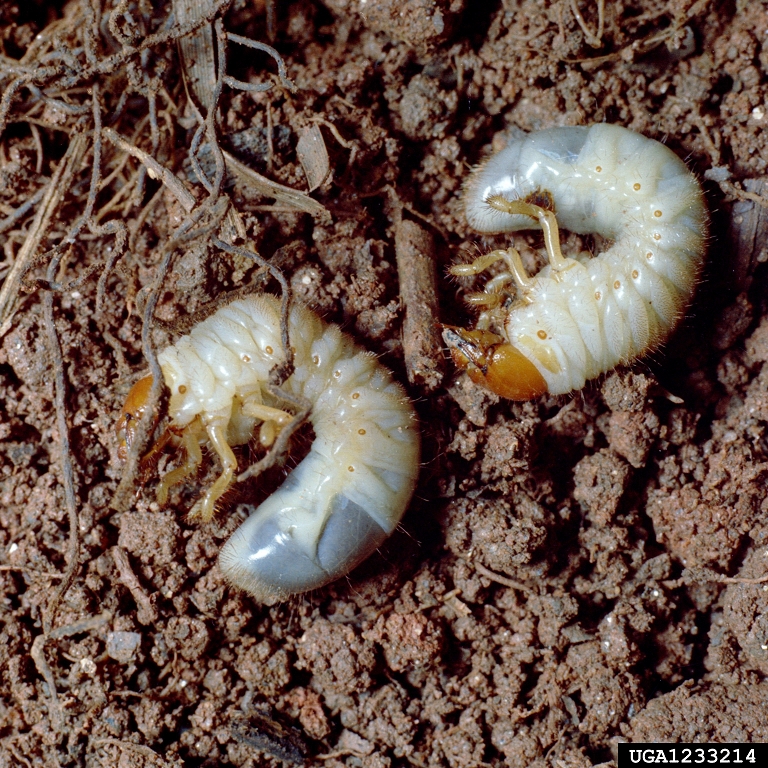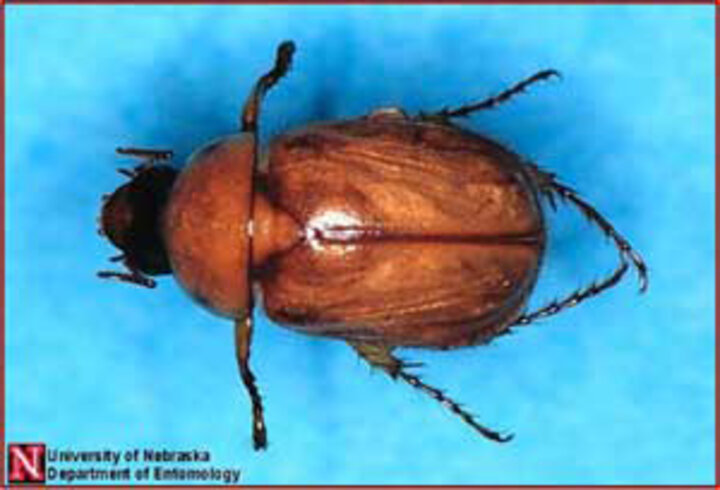Sarah Browning, Nebraska Extension Educator

The term "white grub" actually encompasses the larval stage of several scarab beetles, the most common, and most damaging, being the June beetle or masked chafer, and the Japanese beetle.
One of the most easily recognized insects in the home landscape is the white grub. Almost every gardener has seen white grub larvae in the soil, while installing new plants or tilling the vegetable garden. The term "white grub" actually encompasses the larval stage of several scarab beetles, the most common, and most damaging, being the June beetle or masked chafer, and the Japanese beetle. Less well-known are the May/June beetle and green June beetle. All have a white grub larval stage that can cause damage to turfgrass. The grubs are off white, with six legs located just behind their reddish-brown head and are usually found curled into a "C" shape in the soil.
Identification
Adult June beetles are stout bodied, oval-shaped insects, about 1/2 inch in length, and dark yellow to light brown in color. They are most active at night and, unlike other scarab beetles, do not feed on plants as adults. Japanese beetle adults are slightly smaller, only 3/8 inches in length, with a dark metallic green head and coppery-brown body. They also have 5 tufts of white hairs on the sides of their abdomen. Unlike June beetles, Japanese beetles do feed as adults, and can cause severe damage to a wide range of landscape plants. Roses, oaks and cherries are a few of their preferred plants and can suffered significant defoliation.

Lifecycle
Masked chafers and Japanese beetles have a 1-year lifecycle. Masked chafers are Nebraska native insects, so a few white grubs are common in the spring landscape during planting and do not warrant control. The threshold level for turfgrass damage by masked chafer larvae is 8-10 white grubs per square foot of lawn. One or two insects per square foot is normal and does not require control.
Masked chafers overwinter in the soil in the larval grub stage, however, these mature grubs do little damage and are difficult to kill. So when control is necessary it is targeted at the next generation of insects. After digging in my garden last week, I found mature white grub larva, which means they are right on target to emerge as adults from late June through early July. Watch for the adult beetles around yard lights at night next month.
After mating, females tunnel a few inches into the soil and lay eggs, which hatch in about 14 to 18 days. The new generation of white grub larvae will begin hatching around early July.
Damage
White grubs feed on turf and ornamental plant roots and other organic matter in the soil. Newly established lawns and low maintenance lawns usually have few problems with white grubs. Turf-type tall fescue lawns also have few problems and seldom need preventive treatment.
Kentucky bluegrass lawns maintained at a high level with frequent fertilizer and water applications are most prone to attack. White grub infestations also tend to be localized to preferred locations in the landscape, such as a sunny, irrigated slope or turfgrass underneath a yard light, instead of being uniform. Spot applications of grub control products can be made to areas with a history of attack and not applied to the entire yard if the homeowner prefers.
Damage from root-feeding white grub larvae usually is at it's worst in late July and early August if high insect numbers are present and not controlled. As insects feed on turfgrass roots, small patches of grass turn brown and die. Damage is most severe in hot, sunny locations. Initially damage may appear to be drought injury, or even a disease such as summer patch. But close inspection of affected areas will show that patches of turf can be pulled back easily, like a carpet, and numerous white grub larvae will be found.
Later in the season, September and October, birds and other types of wildlife can cause further damage to your lawn as they rip up turfgrass to find juicy, fat mature grubs.
Control
If you lawn has a history of grub problems treatment may be worthwhile. Imidacloprid (Merit), chlorantraniliprole (Acelepryn) and halofenozide (Mach 2) provide excellent grub control if applied at the right time, which is late June.
In addition to the products mentioned above, commercial lawn professionals may use clothianidin (Arena) or thiamethoxam (Meridian) for control. All products are very effective against young white grubs.
However, if grub control is needed in August or September for an infestation that went unnoticed earlier in the summer, carbaryl (Sevin) or Dylox provide the best control due to their higher kill rate against mature white grubs.
Be sure to water-in grub control products after application for best control.
Image - May/June beetle larvae. Clemson University - USDA Cooperative Extension Slide Series, Bugwood.org.
Search Our Archive
Associated Video
White Grub Control
Nebraska Extension Entomologist Jonathan Larson talks about how to control white grubs in turf, both preventative and curative tips.